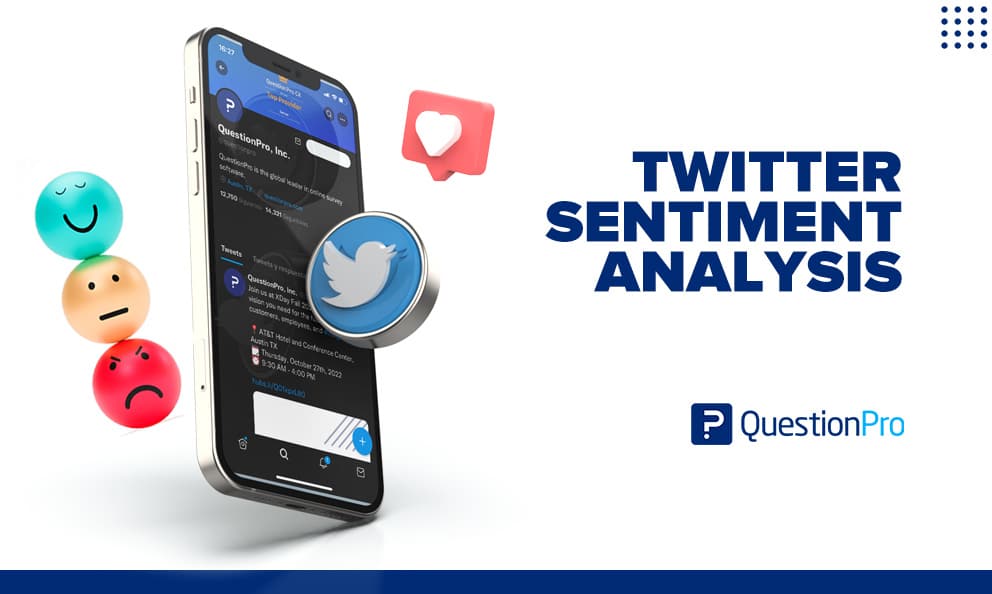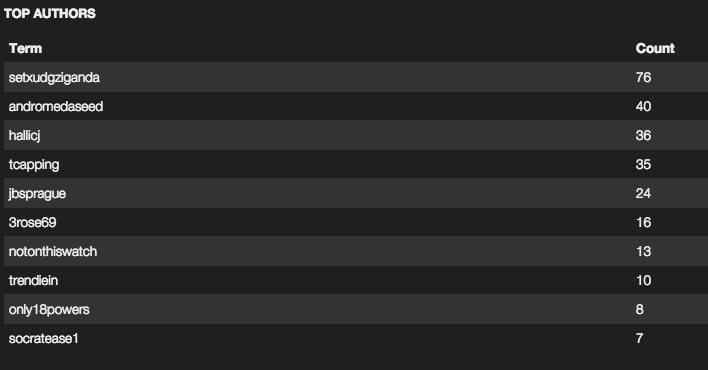 Reading Time: 7 minutes read
Reading Time: 7 minutes readA Twitter sentiment analysis identifies negative, positive, or neutral emotions within the text of a tweet. It is a text analysis using natural language processing (NLP) and machine learning. It identifies and extracts subjective information from original data, providing a company with a better understanding of the social sentiment of its brand, product, or service. At the same time, analyze the online conversations of customers.
Sentiment analysis is frequently used to analyze customer feedback, survey responses, and product reviews.
Some relevant areas of sentiment analysis are monitoring the activities in existing communities within social networks, reputation management, and customer experience.
LEARN ABOUT: Data Analytics Projects
What is Twitter Sentiment Analysis
A Twitter sentiment analysis is the process of determining the emotional tone behind a series of words, specifically on Twitter. A sentiment analysis tool is an automated technique that extracts meaningful customer information related to their attitudes, emotions, and opinions.
The classification of customer conversations around a brand is crucial and can follow the lineaments listed below:
- The most relevant characteristics of a brand’s product or service for customers.
- The customer behavior and intentions around those brand characteristics.
These characteristics are an essential tool for analyzing brand reputation among customers and their conversations concerning the brand with a more human approach.
Why is Sentiment Analysis important?
We can make sense of a company’s qualitative data with sentiment analysis when the information is gathered through different platforms.
-
Voice of Customer (VoC) Programs
Voice of Customer (VoC) Programs is the feedback gathered better to understand customers’ feelings and concerns about a brand. This is crucial for the improvement of customer experience. This data will provide us with risk prevention and develop strategies for better fixing issues concerning the company’s products or services.
Evaluating how customers feel and their opinions can assist you in distinguishing and addressing rising issues. Net Promoter Score (NPS) studies are the best way to conduct these evaluations. Assumption investigation turns the content into the drivers of NPS.
-
Customer Service Experience
An extraordinary client benefit involvement can make or break a company. Estimation investigation and content examination can both be connected to client back discussions. Assumption examination can diminish handling times and increase productivity by coordinating questions with the correct people. Eventually, clients get distant better; a much better a stronger bolster involvement, and you’ll be able to diminish churn rates.
-
Product Experience
Sentiment analysis can identify how your clients feel about the highlights and benefits of your products or services. This may offer assistance and reveal areas of opportunity that may not have been mindful of before. You may mine online item audits for criticism on a particular item category over all competitors in this showcase. You’ll be able, at that point, to apply estimation examination to uncover subjects that your clients feel contrarily approximately. This might uncover openings or joint issues.
-
Brand Sentiment Analysis
The sentiments surrounding a brand are one of the most important factors to consider for a good customer experience. Depending on the brand sentiment, sales increase or decrease. This is also reflected in brand loyalty, where positive sentiments result in good reviews and recommendations, while negative sentiments increase customer churn rates. Sentiment analysis provides brands with tools to monitor how their customers feel about them.
Studying the communities in forums and social media platforms is advisable to be aware of your brand’s reputation. Companies must also track their brand, product names, and competitor mentions to understand the brand image in the big picture. This helps companies assess how a public relations campaign or new product launch has impacted overall brand sentiment.
-
Social Media Sentiment Analysis
Social media can be one of the most capable ways to reach potential clients and keep existing ones. Great client reviews and posts on social media empower other clients to buy from a company. On the other hand, bad reviews and comments can be one of the most harmful advertising out there.
Research by Convergys Corp. affirms that a single negative review on YouTube, Twitter, or Facebook can make a company lose over 30 clients.
-
Market Research
Sentiment analysis can offer assistance for companies to distinguish new trends, analyze competitors, and test emerging markets.
Companies may need to analyze the scores of competitors’ reviews. Using sentiment analysis to evaluate this information can help recognize what clients like or dislike about the competitors.
Twitter Sentiment Analysis Overview
Twitter is a platform created openly for public opinion. The consuming public is not an exception; we are sure to find them on the platform covering current issues. We find opinion leaders, key influencers, and relevant brands on Twitter. By using a Twitter sentiment analysis, companies will have a much clearer perspective on the sentiments of users concerning products and services, market trends, and the successes and failures of the competition. Twitter is an excellent metric of general consumer sentiment. It will be helpful to study a niche and its market trends.
-
Why use twitter for sentiment analysis?
Twitter is a relatively new tool for measuring social studies. We are talking about millions of people voluntarily writing their opinions on any topic. It is an organic data source for data collection and research. Sociological, political, economic, and analytical analyses are currently being carried out, especially for science and business. Twitter is possibly the best place to get a sampling of public opinion.
Studying individual and group reactions to a specific topic is doing sentiment analysis. Although polls are still a phenomenal tool for data collection, the supply of particular tweets on the subject of interest is functional on Twitter. This allows calculating the behavior behind the sentiment in each tweet and then aggregating the results. Companies use this information to gather public opinion about their products and services, avoid risk, and make data-driven decisions.
Until recently, analyzing tweets about a brand, article, or benefit was a manual, complex and monotonous task; it required a person to go through the tweets on the topic one by one, determine which ones were relevant, carefully examine and classify them according to their criteria. It is not only unsustainable but also expensive and time-consuming. It also makes it vulnerable to human error.
Fortunately, technological advances in AI have allowed companies to use machine learning models for tweet sentiment analysis. This way, they can get the knowledge they need when they need it.
Steps to perform Twitter Sentiment Analysis
1. Gather Twitter data
To gather information from Twitter, you must consider:
- Current Tweets: useful to track keywords or hashtags in real time.
- Historical Tweets: valuable to compare sentiments over different periods.
2. Prepare your data
It’s time to prepare the data after selecting the relevant tweets for sentiment analysis. Curation must be done when selecting data to perform a study or sentiment analysis. The better the quality of the selected content, the better the results.
Irrelevant information or substance such as emojis, extra whitespace, off-topic references, etc. need to be removed. As part of the preparation, an in-depth investigation should be done to rule out duplicate or bot-generated tweets, for example.
3. Sentiment Analysis of the data
Tweets that qualify for the quality study can now be submitted to a sentiment analysis tool for investigation.
Visualize the results
Sentiment analysis generates KPI results through graphs and charts to expose the data obtained. Boosting your online reputation score requires establishing significance and trustworthiness for your online presence. You may raise your reputation score by conducting a Twitter sentiment analysis.
The internet reputation of your brand is the most important asset your company can have. Ninety-seven percent of consumers look for local companies online. When potential consumers learn about your company, they form opinions and make purchasing decisions based on their impressions.
What you put online accurately represents who you are for work or pleasure. That footprint grows over time and includes photographs, comments, retweets, and postings on not only Twitter but also Facebook, LinkedIn, Yelp, etc. This interaction leaves a digital trail that may be quickly traced via Google. Your online reputation score is quantifiable, and there are many variables to consider while figuring out how to raise it.
There are two distinct ways of visualizing real-time analysis – basic text analysis or geospatial real-time analysis.
Real-time basic text analysis
Analyzing text from tweets and sentiment scoring real-time is a challenge because you have to process and score data in a streaming manner. Producing an influencer dashboard is also basic in this use case because other data points like ‘location’ and influencer ranking is not taken into account here. If you are curious about what it takes to build a streaming basic analysis from scratch, read more here
Real-time geospatial analysis
For Global brands, understanding what is happening globally is important. Brand reputation can be managed by having regional representation and communication protocols followed with focus on customer expectations. Understanding ‘outbreaks’ and trending in a Google-like map interface makes it easy to understand how different customers in different regions and cultures interpret events. This gets extremely complex very soon because you are dealing with streaming data (text and geospatial data), machine learning and reactive dashboards.
Twitter Sentiment Analysis with QuestionPro
Platforms like QuestionPro will provide you with various tools and functionalities to carry out your sentiment analysis on Twitter and other media.
With QuestionPro CX, you will be able to know in depth what your customers perceive of your brand and evaluate any point of interaction you have with them.
Among its multiple functions, its Sentiment Analysis module will allow you to collect data from your target audience through channels such as social networks and review portals for later analysis, where you can tag and perform advanced data filtering.
As if that were not enough, QuestionPro CX is much more than a sentiment analysis tool. You can also carry out various satisfaction, reputation management, and social listening studies to boost your brand by improving your public’s perception of you.
Do you want to know more about our tool? We will be delighted to talk with you!























